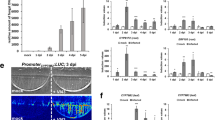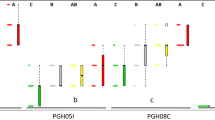Abstract
The virulence of two wild type (PA45 and PA37) and two genetically modified (13C: hygromycin resistant; FATSS: hygromycin resistant and β-cin knock-down) Phytophthora cinnamomi strains towards cork oak (Quercus suber) was assessed via a quantitative evaluation of disease symptoms arising from a soil infestation assay, and by a histological analysis of root colonization. Comparison of virulence, as expressed by symptom severity, resulted in the following ranking: highly virulent (wild type strains), medium virulence (strain 13C) and weakly virulent (FATSS). Both transgenic strains were compromised in their virulence, as expressed by symptom severity, but strain 13C was much less affected than FATSS. Microscopic observation showed that the FATSS strain was unable to effectively invade the root, while 13C and the two wild type strains were all able to rapidly colonize the whole root, including the vascular tissue. These results strengthen the notion that elicitins are associated, either directly or indirectly, with the infection process of Phytophthora.







Similar content being viewed by others
References
Bergot, M., Cloppet, E., Pérarnaud, V., Déque, M., Marcais, B., & Desprez-Loustau, M. L. (2004). Simulation of potential range expansion of oak disease caused by Phytophthora cinnamomi under climate change. Global Change Biology, 10, 1539–1552.
Brasier, C. M. (1996). Phytophthora cinnamomi and oak decline in southern Europe. Environmental constraints including climate change. Annales des Sciences Forestières, 53, 347–358.
Brasier, C. M. (2008). The biosecurity threat to the UK and global environment from international trade in plants. Plant Pathology, 57, 792–808.
Brasier, C. M., Robredo, F., & Ferraz, J. F. P. (1993). Evidence for Phytophthora cinnamomi involvement in Iberian oak decline. Plant Pathology, 42, 140–145.
Brummer, M., Arend, M., Fromm, J., Schlenzig, A., & Oβwald, W. F. (2002). Ultrastructural changes and immunocytochemical localization of the elicitin quercinin in Quercus robur L. roots infected with Phytophthora quercina. Physiological and Molecular Plant Pathology, 61, 109–120.
Caetano, P. (2007). Envolvimento de Phytophthora cinnamomi no declínio de Quercus suber e Q. rotundifolia: estudo da influência de factores bióticos e abióticos na progressão da doença. Possibilidades de controlo químico do declínio. Tese de Doutoramento (p 321) Universidade do Algarve.
Cahill, D., Legge, N., Grant, B., & Weste, G. (1989). Cellular and histological changes induced by Phytophthora cinnamomi in a group of plant species ranging from fully susceptible to fully resistant. Phytopathology, 79, 417–424.
Coelho, A. C., Cravador, A., Bollen, A., Ferraz, J. F. P., Moreira, A. C., Fauconnier, A., et al. (1997). Highly specific and sensitive non-radioactive identification of Phytophthora cinnamomi. Mycological Research, 101, 1499–1507.
Colas, V., Conrod, S., Venard, P., Keller, H., Ricci, P., & Panabiéres, F. (2001). Elicitin genes expressed in vitro by certain tobacco isolates of Phytophthora parasitica are down regulated during compatible interactions. Molecular Plant-Microbe Interactions, 14, 326–335.
Correia, T. P. (1993). Threatened landscape in Alentejo, Portugal: the “montado” and other “agro-silvo-pastoral” systems. Landscape and Urban Planning, 24, 43–48.
Correia, A. V., & Oliveira, A. C. (2002). Principais espécies florestais com interesse para Portugal, Zonas de Influência Mediterrânica. Estudos e Informação nº 318, 2ª Ed., Direcção Geral das Florestas, Lisboa.
Duclos, J., Fauconnier, A., Coelho, A. C., Bollen, A., Cravador, A., & Godfroid, E. (1998). Identification of an elicitin gene cluster in Phytophthora cinnamomi. DNA Sequence—Journal of Sequencing and Mapping, 9, 231–237.
Érsek, T., Schoelz, J. E., & English, J. T. (1994). Characterization of selected drug resistant mutants of Phytophthora capsici P. parasitica and P. citrophthora. Acta Phytopathologica et Entomologica Hungarica, 29, 215–229.
Erwin, D. C., & Ribeiro, O. K. (1996). Phytophthora diseases worldwide. St Paul: American Phytopathological Society.
Gaulin, E., Jauneau, A., Villalba, F., Rickauer, M., Esquerré-Tugayé, M.-T., & Bottin, A. (2002). The CBEL glycoprotein of Phytophthora parasitica var. Nicotianae is involved in cell wall deposition and adhesion to cellulosic substrates. Journal of Cell Science, 115, 4565–4575.
Hardham, A. (2005). Pathogen profile: Phytophthora cinnamomi. Molecular Plant Pathology, 6, 589–604.
Horta, M., Sousa, N., Coelho, A. C., Neves, D., & Cravador, A. (2008). In vitro and in vivo quantification of elicitin expression in Phytophthora cinnamomi. Physiological and Molecular Plant Pathology, 73, 48–57.
Jeffers, N. S., & Martin, J. B. (1986). Comparison of two media selective for Phytophthora and Pythium species. Plant Disease, 70, 1038–1043.
Jiang, R. H. Y., Tyler, B. M., Whisson, S. C., Hardham, A. R., & Govers, F. (2006). Ancient origin of elicitin gene clusters in Phytophthora genomes. Molecular Biology and Evolution, 23, 338–351.
Joffre, R., Rambal, S., & Ratte, P. J. (1999). The dehesa system of southern Spain and Portugal as a natural ecosystem mimic. Agroforestry Systems, 45, 57–79.
Jung, T. (2009). Beech decline in Central Europe driven by the interaction between Phytophthora infections and climatic extremes. Forest Pathology, 38, 73–94.
Kamoun, S. (2007). Groovy times: filamentous pathogen effectors revealed. Current Opinion in Plant Biology, 10, 358–365.
Kamoun, S., Van West, P., De Jong, A. J., De Groot, K. E., Vleeshouwers, V. G. A. A., & Govers, F. (1997). A gene encoding a protein elicitor of Phytophthora infestans is down-regulated during infection of potato. Molecular Plant-Microbe Interactions, 10, 13–20.
Kamoun, S., van West, P., Vleeshouwers, V. G., de Groot, K. E., & Govers, F. (1998). Resistance of Nicotiana benthamiana to Phytophthora infestans is mediated by the recognition of the elicitor protein INF1. Plant Cell, 10, 1413–1425.
Lherminier, J., Benhamou, N., Larrue, J., Milat, M.-L. Milat, Boudon-Padieu, E., Nicole, M., et al. (2003). Cytological characterization of elicitin-induced protection in tobacco plants infected by Phytophthora parasitica or phytoplasma. Phytopathology, 93, 1308–1319.
Moreira-Marcelino, A. C. M. (2001). Aspectos da interacção entre Phytophthora cinnamomi e a doença do declínio em Q. suber e Q. rotundifolia. Tese de Doutoramento (p 279) Universidade do Algarve.
Picard, K., Ponchet, M., Blein, J. P., Rey, P., Tirilly, Y., & Benhamou, N. (2000). Oligandrin, a proteinaceous molecule produced by the mycoparasite Pythium oligandrum induces resistance to Phytophthora parasitica infection in tomato plants. Plant Physiology, 124, 379–395.
Pires, N., Maia, I., Moreira, A., & Medeira, C. (2008). Early stages of infection of cork and holm oak trees by Phytophthora cinnamomi. In J. Vázquez & H. Pereira (Eds.), Suberwood: New challenges for the integration of cork oak forests and products (pp. 275–282). Spain: Universidad de Huelva.
Ponchet, M., Panabières, F., Milat, M.-L., Mikes, V., Montillet, J.-L., Suty, L., et al. (1999). Are elicitins cryptograms in the plant—Oomycete communications? Cellular and Molecular Life Sciences, 56, 1020–1047.
Roland, J. C., & Vian, B. (1991). General preparation and staining of thin sections. In J. L. Hall & C. Hawes (Eds.), Electron microscopy of plant cells (pp. 1–66). London: Academic.
Sánchez, M. E., Caetano, P., Ferraz, J., & Trapero, A. (2002). Phytophthora disease of Quercus ilex in south-western Spain. Forest Pathology, 32, 5–18.
SPSS for Windows, Rel. 11.0.1. 2001. Chicago: SPSS Inc.
Steel, G., & Torrie, J. (1985). Bioestadística: Principios y Procedimientos. Bogotá: MacGraw-Hill.
Widmer, T. L., Graham, J. H., & Mitchell, D. J. (1998). Histological comparison of fibrous root infection of disease-tolerant and susceptible citrus hosts by Phytophthora nicotianae and P. palmivora. Phytopathology, 88, 389–395.
Zentmyer, G. A. (1980). Phytophthora cinnamomi and the diseases it causes. Monograph No. 10 (p. 96). St Paul: American Phytopathological Society.
Acknowledgements
This research was financed by the EC—III Framework Programme for Research and Technological Development, co-financed by the European Social Fund (ESF) and by national funding from the Portuguese Ministério da Ciência e do Ensino Superior (MCES) (PTDC/AGR-AAM/67628/2006). M. Horta thanks Fundação para a Ciência e a Tecnologia (FCT) and ESF (EC—III Framework Programme) for her grant (SFRH/BD/1249/2000).
Author information
Authors and Affiliations
Corresponding author
Rights and permissions
About this article
Cite this article
Horta, M., Caetano, P., Medeira, C. et al. Involvement of the β-cinnamomin elicitin in infection and colonisation of cork oak roots by Phytophthora cinnamomi . Eur J Plant Pathol 127, 427–436 (2010). https://doi.org/10.1007/s10658-010-9609-x
Accepted:
Published:
Issue Date:
DOI: https://doi.org/10.1007/s10658-010-9609-x




